For years, smartphones have been ruling the global consumer electronics industry and the technology world with endless advancements and wide-ranging product options. However, today, there is one new tech contender that is making great strides in the global market, and competing for the top spot: wearable technology – a sensor, gadget, or electronic device that can measure, report and analyze any data we might desire.
From high-tech fashion jewelry to smartwatches and fitness bands that track your activity, mood, and even your pets, wearable electronics are the next big thing in the consumer electronics industry.
The names that reign supreme in the wearable devices market will probably not come as a surprise to most tech investors. Nevertheless, it isn’t just the big tech companies that are investing in wearable electronics; many of the most innovative ideas and products are coming from start-ups that are helping to lay the foundations for a hyper-connected future.
Here are the top wearable companies dominating the global market and poised to grow significantly in 2018.
1. Apple
Following the release of its third generation Apple Watch in September 2017, the U.S. technology giant Apple has once again clinched the top spot in the wearable electronics market. The cellular version of the Apple Watch is in strong demand in the U.S., Australia, and Japan. As per our research, the company sold eight million watches in the final quarter of 2017, the most since the Apple Watch was introduced and the maximum number of shipments in a single quarter for any wearable vendor.
Apple has won the wearables game and its recent updates to the Series 3, such as Apple Heart Study and Gymkit, are proving to offer compelling applications and use cases, encouraging users to spend more on gadgets. Features like health and fitness tracking and the ease of taking phone calls from your wrist will continue to give the Apple’s wearables business an edge over competitors, especially as new applications are added.
2. Samsung
Samsung Electronics, a leader in the smartphone segment, made strides in the wearables electronic industry in 2017, overtaking its rival Fitbit. Recent research attributes the growth of Samsung’s wearables market share to strong sales of the Samsung Gear S3. This wearable device has been a hit mainly because it boasts a long battery life as well as offers extra functionality including Samsung Pay.
As part of its active move from style to sports, the company unveiled a trio of wearable devices with a more in-depth focus on health and fitness: the Gear Sports smartwatch, Gear Fit 2 Pro fitness band and the Gear IconX 2018 wireless earbuds. The sports wearable from Samsung looks like a formidable competitor to Fitbit’s Ionic.
3. Fitbit
Founded in 2007, Fitbit has long led the wearable category with its well-known line of wrist-worn fitness trackers. However, the company had difficulties in 2017, which prompted layoffs. The struggle continued when Apple surpassed Fitbit as the top wearable maker in the world, thanks to Apple Watch. Nevertheless, Fitbit has put the wheels in motion and has recently recovered some ground.
As a first step, the company launched its latest round of products in October 2017, entering two entirely new sections on the same old formula of wrist-based fitness bands. The company released one product in 2017 that gained massive appeal in the wearable device sector: Fitbit Alta HR. Fitbit also recently launched its first smartwatch, known as Fitbit Ionic, which offers a highly personalized experience not previously seen in other smartwatches.
4. Xiaomi
Although Xiaomi is experiencing gloomy market predictions due to a major decline in their smartphone business, the China-based electronics company is now getting a boost from its wearable product line. Xiaomi’s Mi Band fitness trackers are most recognized systems in China, owing to their cutting edge features including heart-rate monitors, calendar alerts, step counters, and their highly competitive pricing strategy.
With a year-on-year growth of about 96 percent, Xiaomi’s progress in the wearable industry is tremendous. Xiaomi had resurgence in 2017, regaining its market share after two disappointing years in which the company missed sales targets. Remarkable progress in India, where the company cracked more than $1 billion in revenue last year, and a push into offline retail in China have contributed to a more optimistic outlook this year.
5. ODG
ODG (Osterhout Design Group) is one of the leading wearable companies, which is most popular for its medical and industrial heads-up displays, made its first foray into the consumer market last year. It announced two pairs of glasses, R-8 and R-9, after major fundraising, plus a recent partnership with China Mobile’s Migu Video.
The R-8 and R-9 glasses, which are cheap and compact, are both backed by the innovative Qualcomm Snapdragon 835 chip, and they are powered by ODG’s Android Nougat 7.0-based Reticle OS. Consequently, they can place digital products in real space. The R-series will produce the broadest portfolio of high-performance, integrated smartglasses on the planet.



